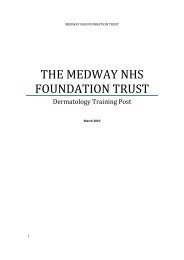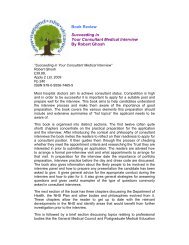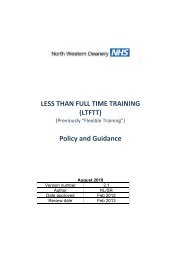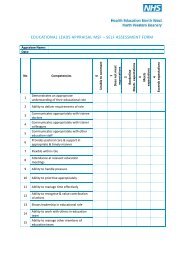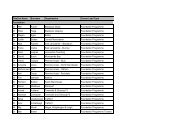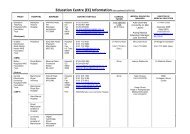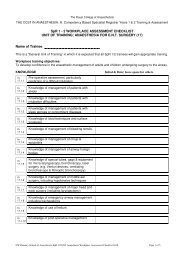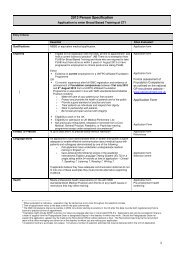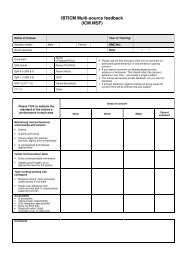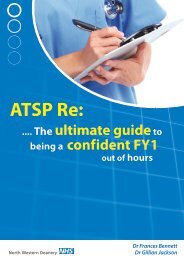Rota Design for 2009 - North Western Deanery
Rota Design for 2009 - North Western Deanery
Rota Design for 2009 - North Western Deanery
- No tags were found...
You also want an ePaper? Increase the reach of your titles
YUMPU automatically turns print PDFs into web optimized ePapers that Google loves.
5. Pitfalls to avoid<strong>Rota</strong>s monitoring into higherpay bandsi. New Deal maximum shift durationWhen planning towards WTD compliant rotas it’s criticalto be mindful of New Deal rules that may trip you upleading to Band 3 claims you had not expected. Themost challenging of these are often the rules in relationto the maximum shift duration permissible on differentworking patterns.On call rotasThe 32 hour and 56 hour rule has caused havoc onmany non resident rotas in the surgical sub-specialties inparticular, but also in specialties such as Oncology. AsWTD rules do not stipulate any limits on non residentduty hours, these areas are often overlooked whenplanning WTD compliant rotas.Essentially these rules exist to ensure that after aweekday or weekend on call the junior doctor leaves ontime eg 5pm following a 9am start the preceding day <strong>for</strong>a weekday on call. This of course presumes a 9am startalthough it’s common practice <strong>for</strong> surgeons to start theirnormal working day at 8am.The knock on impact of this is that surgical trainees mustfinish early on the day post on call, <strong>for</strong> example by 4pm,to avoid breeching the 32 hour and 56 hour rule. In realitythis can be difficult to achieve if the trainee is in theatre ora clinic. It’s important to note that this New Deal rule isabsolute, ie it must be adhered to on 100% of occasions,so a single breech can lead to a successful Band 3 claim.Certain provisions may be considered to minimisepossible breeches:●Ensure when a junior doctor is on call they are notrostered <strong>for</strong> a theatre list or out patient clinic on thefollowing afternoon, which may prevent them fromleaving work on time●●junior doctors <strong>for</strong> clinics and theatres on their halfdays off, making it impossible <strong>for</strong> the juniors to leaveearly. It is often far more effective to roster a full dayoff after on-call but this does of course haverepercussions <strong>for</strong> training and the serviceIf additional time off is rostered on the rota eg halfdays off or full days off, ensure this is communicatedclearly to all the teams within the department,including junior doctors, senior doctors and nursingstaff. If possible incorporate the requirement <strong>for</strong> thetrainees to be off duty after eg 2pm post on call,within a departmental policyConsider a late start <strong>for</strong> the first day on call eginstead of coming to work at 8am roster the juniordoctor to start at 10am. This would accommodate<strong>for</strong> late finishes the following day up to 6pm,without breeching the 32 hour and 56 hour rule. Itis also easier to comply with a late start, comparedto trying to leave early on the day post on call. Theeducational and service impact of late starts must betaken into account as handover and ward roundscould possibly be missed.24 hour partial shiftsThe maximum possible shift duration on these rotas is24 hours and again this rule is absolute and so must befulfilled on 100% occasions otherwise the rota maydefault to Band 3.This makes handover on such rotas challenging and arange of different solutions are available:●●●Written handoverElectronic handoverCreating an extended shift whereby one traineeeach week comes to work 30 minutes early to takethe handover from the doctor finishing their 24 hourshift be<strong>for</strong>e they leave.●Roster in a half day off duty post on call to ensurethe junior doctor has left work be<strong>for</strong>e 4pm. In realityhalf days are often poorly communicated by trustsand rarely taken by juniors so proceed with caution.In particular some trusts have continued to rosterWhere resident 24 hour partial shift rotas are inoperation or being considered <strong>for</strong> use, trusts mustconduct their own local risk assessment in relation tothe WTD compliance of these working patterns.28



